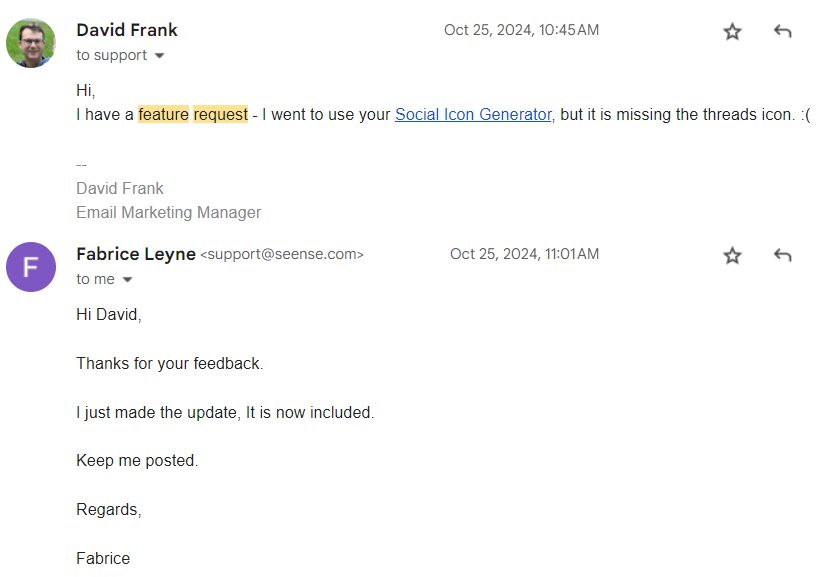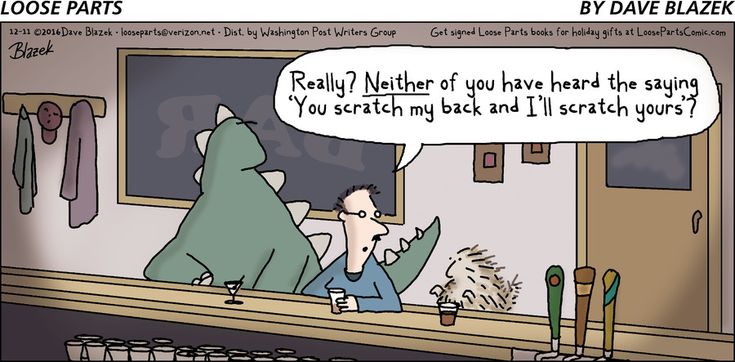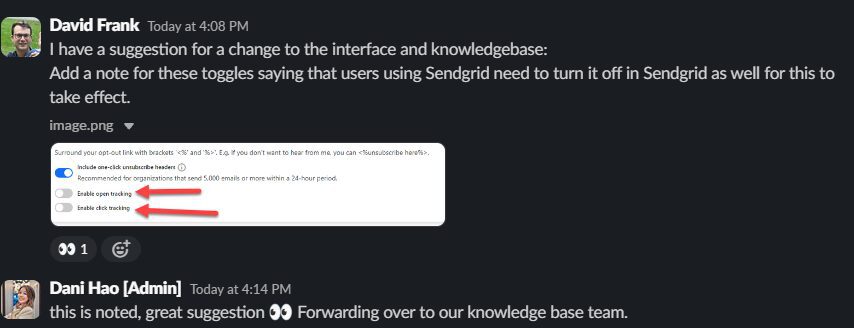Why is no one talking about feature requests and feedback when discussing automation? As a user of many SaaS products, it’s easy to curse poorly designed features, but why yell at the sky with your fist to the heavens when you can politely ask for an update from the cloud. AI and automation are rightly lauded as the best way to boost efficiency, but I’m yet to see a single article or educational resource promote reaching out to developers with product change suggestions, feature requests, or better documentation. We’ve been using agile development and SaaS products for years, so there’s no reason not to do encourage it.
Feedback, suggestions and requests can be sent to a generic “contact me” mailboxes or to the support team, but for a higher likelihood of success, post publicly in their own forum, Subreddit or slack community where others can comment in support of this, or ask your account manager, who is more likely to put a request directly the development team or internal product development board. Your account manager has a vested interest in keeping you happy after all, lest you discontinue the service, and it’s a great way for them to look like they’re making their mark on the product.
Perhaps it has something to do with what psychologists call “locus of control” – “the degree to which people believe that they, as opposed to external forces (beyond their influence)” (Wikipedia). Those with a strong “internal locus of control” believe things in their life are primarily a result of their own actions (as we will explore in this article), whereas those with “external locus of control” tend to praise or blame external factors – in this case, an issue or missing feature in a digital product one is using. Here, I am asking you to have the gumption to take minimal steps get something fixed, in the manner of someone with internal locus of control.
Contents
Have the chutzpah to ask for changes to free tools
The problem: I needed to develop and deploy a new company-wide email signature template, and the social icons needed to match our brand color scheme. I had the hex color code ready to go. There are plenty of icon libraries, including some icon generation services that will spit out whatever color, dimensions and file type you need. However, with the recent launch of Threads, I couldn’t find a free service that included Threads. After wasting almost an hour on this task, I clicked the Contact Us button on the Mad Birdies Social Icon Generator (https://madbirdies.com/esc/socialicons/) and sent a 1 line email. They created this free tool as a way to promote their larger paid email signature program, and I expected little, but 16 minutes later it had been done, and 2 minutes after that I finished my project.

Making yourself look less bad when a gap in documentation is to blame
Your boss wants you to be competent, and a demonstrated attitude whereby you fix a problem, rather than just complain about it. You want to minimise to your reputation from your mistakes. Here’s an example of a mistake I made, and a way I turned it into a bit of a win in other ways.
I recently disabled link and open tracking for one of the seats on one of my employer’s email platforms, Apollo.io. This is a best practice to improve email deliverability, and this big change had my company’s senior leadership’s eyes on it, as it took some convincing to give up these useful metrics in order to boost deliverability, engagement, and hopefully ultimately sales. However, two weeks after the change a colleague noticed we’re still getting those metrics when they should be 0. After wasting time researching the solution, I had to lodge a support ticket. Their support team informed me that this setting needs to be toggled in external mail routing platform Sendgrid as well, if you’re using that, which we were.
I let my boss know of the mistake and delay for it to be properly implemented, and yeah, I looked a little incompetent for not knowing this one, a counter-intuitive, obscure thing not covered in any of the documentation.
So one way of preserving my reputation internally is by letting my bosses know there was a gap in the description in the platform’s interface and documentation which the vendor has updated at my request.
This was one of three feature requests I gave Apollo via their Slack community in one day.
In another, where I felt a knowledgebase article had let me down, I copied the text to a Google Doc and made suggested changes to include information I wish I had known earlier, which I then shared with the provider. Here was the feedback I received:
“I personally appreciate customers like you who put a lot of thought into your processes and willing to put the time into giving such detailed feedback. Will make sure this is seen by the right parties” – Dani Hao, Sr Manager – Community, Apollo.io
Explain how you use the product – give them their CX research for free
Every time I need to find something in a list of options that is not in alphabetical order, I die a little inside. Searching isn’t possible for drop down menus either. It demonstrates a lack of concern for customer experience (CX).
HubSpot still lists HubSpot Inbox mailboxes (which can get to hundreds in large organisations) out of order, despite me sending a note to our account manager saying
“Would it kill the devs to put inbox mailboxes in alphabetical order, or support sorting? It makes for a frustrating CX. Any chance you can lodge a feature request for us?”
We got the following response, but no action on this one.
“Good point! I filed a roadblock/feature request in your account.”
I sent similar feedback to Apollo.io, however I went step further, explaining that the customer experience would be improved not just by allowing to sort email addresses alphabetically, but also group by domain, as users often need to edit mailboxes at the same domain.
Companies pay huge amounts for CX insights into how users use their products, so volunteering details of your workflow is useful information to them. Don’t hesitate to explain how you do things, and why.
Apollo have actioned some of my feature requests that have previously helped me boost my productivity. I asked them to enable ctrl+click or middle click to open a link in a new window where it was not working, and though it took a while, it was deployed. This was for a repetitive task and saved me untold time, which I get to boast in team meetings! I’ve become known as not just a highly efficient worker, but one who gets things out of other people too, for the benefit of the company.
Getting tangible reciprocal benefits (beyond cost reduction)
Another one of my vendors, email warmup service warmy.io is based in Eastern Europe. The trust we have built up mutually is significant, with with many benefits for both parties.
1) I’ve let them know of simple misspellings. E.g. “Already registrated? Sign in”.
2) I’ve told them about a couple broken links in some email newsletters
3) I have mentioned many other user interface bugs
4) I have made automation suggestions for tasks I currently do manually. E.g. they provided a list of list to import to your email platform, but my email platform (apollo.io) doesn’t accept a simple copy and paste like this, so I had to copy them to Excel, convert commas to line breaks, then save it as a CSV file that my database could handle. A PITA manual task. I requested the option to download it as a single file, and now it’s available as an easily convertible XLSX file, saving me time.
5) I beta tested their email validation tool
6) I was questioned about what I’m looking for in a training program so they can develop one around customer needs.
I can’t share the exact details of what they’ve done to thank me, but I have sent several emails to my boss saying things like
– “our monthly fee went down because I negotiated a better bundle”
– “we no longer need to pay for XYZ expensive third party tool because Warmy will throw it in our bundle with them for free” and
– “we no longer need to invest hours in this problem of ours because Warmy’s staff are generously solving it for us for free.”
My department is under-budget, I look VERY good to my boss, and the investment was good.
A whole career of success from being an outstanding customer
The best successes I have had in my career are from the relationships I built with my vendors. ASKING for help not only uses the Benjamin Franklin Effect to get people to like you, but also encourages them to go out of their way to help you further.
My final example is my first marketing job over 15 years ago, which included being in charge of sourcing hardware from wholesalers. Through the relationships I built, being not just a pleasant human being, but helping them out by offering feedback when I had it, having greater flexibility non-urgent deliveries, paying invoices on time, and being quick, plain and simple to deal with, I secured lower thresholds for bulk discounts, free shipping at lower tier of purchases, expedited shipping for free when I needed it, early access to products, and early, honest insider information. I think people believe “companies don’t listen anyway, so why bother,” but if the cost is low to yourself, and especially you also have a relationship to boost and leverage, my success suggests going for it. They worst they can do is ignore you or say “no”.

What features have you had the gumption to ask for, and did you get them? Let me know in the comments and I may incorporate it into this article.
This article was written without the help of AI. Feedback is most welcome.






